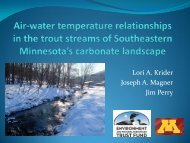Great Lakes Regional Water Program Great Lakes Regional Water
Great Lakes Regional Water Program Great Lakes Regional Water
Great Lakes Regional Water Program Great Lakes Regional Water
Create successful ePaper yourself
Turn your PDF publications into a flip-book with our unique Google optimized e-Paper software.
National Theme <strong>Water</strong>shed Management<br />
<strong>Water</strong>shed management recognizes that the water quality of our streams, lakes, and estuaries results from<br />
the interaction of upstream features. <strong>Water</strong>shed management programs unite social, economic, and<br />
environmental concerns with research devoted to “scaling-up” the cumulative effects of site-specific actions<br />
on rangelands, forests, agricultural lands, and rural communities.<br />
Effective planning and long-term change in impaired watersheds requires citizen participation in many stages<br />
of the process. CSREES and the Land Grant Universities, with their system of community-based educators<br />
carrying out public outreach education, are uniquely poised to direct programming to increase community<br />
involvement in watershed management. CSREES Extension programs educate agricultural producers,<br />
residents, and community decision makers on water quality and watershed management issues using a wide<br />
array of programming, including workshops on the Total Maximum Daily Load (TMDL) process, model and<br />
geographical information system (GIS) demonstrations, hands-on training of watershed-scale tools available<br />
to reduce pollution risks within watersheds, and media publications. Extension supports numerous volunteer<br />
water quality monitoring programs that educate and empower volunteers while collecting valuable data to<br />
assess water quality before and after watershed restoration. The CSREES network is engaging stakeholders in<br />
the watershed management process, resulting in changing attitudes and behaviors that reduce contamination<br />
throughout watersheds and consequently improve water quality.<br />
<strong>Regional</strong> <strong>Program</strong>ming Success Story<br />
Developing a Social Component for the USEPA<br />
Region 5 Nonpoint Source Evaluation Framework<br />
7<br />
SITUATION:<br />
State Nonpoint Source (NPS) management programs are implemented to improve and protect water resources in a variety<br />
of ways. Environmental management and stakeholder education and outreach are both important to achieving and maintaining<br />
long-term water quality goals. Most state environmental agencies have the necessary expertise to address the<br />
environmental dimension of water quality management, but lack expertise in the human dimensions of water quality, such<br />
as fostering behavior change. In addition, because the effectiveness of public funding is being closely scrutinized in every<br />
agency, the need for outcome-based program evaluations is high. Evaluation expertise exists at the regional and state<br />
program levels, but is constrained by high workloads and limited funding.<br />
USEPA Region 5, state environmental agencies, and the <strong>Great</strong> <strong>Lakes</strong> <strong>Regional</strong> <strong>Water</strong> <strong>Program</strong> have recognized the need to<br />
understand and include human dimension indicators to help evaluate progress toward water quality goals in the region.<br />
Of particular interest are indicators associated with behavioral changes that reduce threats to water resources but do not<br />
immediately translate into measurable water quality differences, as well as contextual information about watersheds that will<br />
provide insight into the system in which NPS management is taking place.<br />
17

















